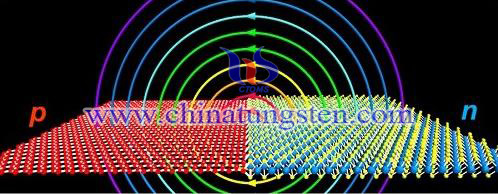Two-Dimensional Tungsten Disulfide/Tungsten Trioxide Monohydrate Lateral Heterojunction Preparation
Heterojunction two-dimensional material is the cornerstones of constructing nanoelectronics and optoelectronics "buildings", and to be tie basic elements of modern semiconductor industry, which plays an important role in the high-speed electronic devices and optoelectronic devices. Two-dimensional layered materials, including graphene, transition metal disulfide (tungsten, molybdenum, etc.), because of their unique electrical and optical properties, they can act as a constituent unit of the heterostructure. Lateral heterojunction two materials are connected by a covalent bond is formed, because of its simple method for constructing, it has a greater potential in terms of applying in band-gap engineering. With the advent of nano-science and nano technology, the development of plasmon nanostructure is really rapid, and scientists have prepared hydrogen doped of MoO3 and WO3 which are namely hydrogen bronze (hydrogen molybdenum bronze and hydrogen tungsten bronze) by simple H-overflow method, and exhibit strong localized surface plasmon resonance in the visible region. The results provide direct evidence on the hydrogen-doped metal oxide semiconductor implement plasmon resonance, and may allow large-scale application of low-cost and abundant earth element.

This article provides a method for preparing two-dimensional tungsten disulfide / tungsten trioxide monohydrate lateral heterojunction, and its specific steps are as follows:
1. Disperse the 50-100 parts by mass of tungsten disulfide in 5-10 parts by volume of water or ethanol to form a dispersion, wherein the concentration of ethanol can be any volume;
2. Place the dispersion in the reactor of supercritical carbon dioxide at the conditions of 40-45°C, 6-20MPa to stir for 0.5~7h, decrease the atmospheric pressure to the normal value after the reaction is completed, and remove the unpeeled tungsten disulfide;
3. Remove the solvent after completing air oxidation (the solution appears in dark green before the oxidization, and turns pale yellow or bright yellow after it is oxidized), then obtain the two-dimensional tungsten disulfide / tungsten trioxide monohydrate lateral heterojunction.
Supercritical carbon dioxide with its high diffusion and low surface tension and other properties makes it can be the penetrant and expander to open gap between tungsten disulfide layers; stirring finally separate the sheet, so that the single layer of tungsten disulfide in the supernatant after centrifugation will be oxidized to monohydrate tungsten trioxide in the air, and to form two-dimensional / tungsten trioxide monohydrate lateral heterojunction eventually. This heterogeneity structure separates the electron-hole pairs, and has good prospects for development on the photocatalytic degradation of organic compounds and photocatalytic hydrogen production and other fields.
If you have any other question or inquiry of tungsten oxide, please feel free to contact us through the following methods:
Tel.: +86 592 5129696/86 592 5129595
Fax: +86 592 5129797



评论
发表评论